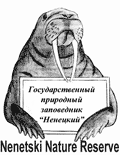
An International Polar Year initiative to use predators as indicators of arctic changes
| |
| Home |
| Project Structure |
| The team |
| Field sites |
| Publications |
| Isotopes |
| News |
| Workshops |
Selected stable Isotopes analyzing tools ## IsoSource download ## SIAR now new version working with R2.8.1 and further download ## Download FATSim 1.0 an R-script to simulate the effect of extracting/not extracting lipids on the outcome of stable isotope mixing models ## here are the instructions of how to use FATSIM
## Download SampleSim and the instructions a beta version of a R-script to simulate the effect of sample size on the outcome of stable isotope mixing model
## Download TurnoverSim a beta version of a R-script to simulate whether experiments were able to achieve the requirements for measuring isotopic incorporation into tissues
## Go to download R here
STABLE ISOTOPES & PREDATOR-PREY MEETING PUBLIC CONFERENCE 17 March 2009 A MEETING COMPOSED OF PUBLIC CONFERENCES AND A WORSHOP TO PICTURE HOW STABLE ISOTOPES ARE USED TO DECIPHER PREDATOR-PREY INTERACTIONS
AGENDA FOR THE PUBLIC CONFERENCES Tuesday, 17 March morning, Room 1207 Auditorium Powerpoint version of the presentations are available for download
8:30 Welcome words
Abstract - Signatures of naturally occurring stable isotopes of Carbon and Nitrogen have been used in dietary analyses for many animals. They have also successfully been used in sorting out trophic relationships. By using samples from the same type of tissue across different time intervals it is also possible to get information about dietary change. However, there are some problems by using stable isotopes in ecological analyses that sometimes are ignored. There are at least four processes that affect the isotopic signature. The (1) isotopic composition of prey consumed is the most used one, but it is very important to know (2) the fractionation of the different tissues. There might also be a considerable difference in (3) turnover rate for different tissues. Another problem that is often ignored is the isotopic routing that might take place.
Abstract - Rats are one of the most successful and most damaging invaders. Their diet adaptability (breadth and flexibility), although known to be one reason for their high impact on many species, plant and animals alike, still lacks concrete evidence. In this study, we tried to assess the impact of introduced rats, Rattus rattus, on a simple ecosystem (Surprise Island, a small and uninhabited off New Caledonia) in two different seasons with contrasted food resources. By combining observations, classical diet (stomach and feces contents) and stable isotopic analyses, we show that rats have a heavy impact on most present seabird species, which constitute a large fraction of their diet. Outside the breeding season rats preyed heavily on an ephemeral but very abundant resource: the hatchlings of sea turtles, Chelonia mydas, which could then constitute up to 45% of their diet. During that short period of seabird egg absence, rats maintained a good body condition and high abundance. They moved from the mainland to the coast, where hatchling turtles were available. The possibility of rapid and temporary shifts between endangered taxa in the diet of introduced rodents may cause unexpected heavy predation on these species and should be accounted for in conservation programs.
Abstract - Applications of stable isotope techniques to ecological questions have been around for some time. Yet among animal ecologists it has been something of "slow burner" with a surprisingly low uptake. If applied correctly these approaches have the potential to yield remarkable insights into the lives of animals. Here we discuss the use of stable isotopes as dietary markers covering a range of potential applications in both birds and bats. We follow this by discussing some of the latest ideas on how stable isotopes may be used to generate community metrics and if time permits will close by detailing the important assumptions and caveats associated with stable isotope analyses.
10:30 Overview of tools to analyze stable isotopes Abstract - Stable isotope analysis is increasingly being utilised across broad areas of ecology and biology. Key to much of this work is the use of mixing models to estimate the proportion of sources contributing to a mixture such as in diet estimation. Mixing models have become increasingly sophisticated in recent years and have largely overcomes some of the rather constraining limitations of earlier models. The latest models, adopting a Bayesian framework, enable us to examine increasing complex system, and may offer the first steps towards using stable isotopes to quantify community level metrics. Here we examine the development of tools to analyses stable isotope data illustrating there utility in a wide range of systems.
BREAK
11:15 Use and abuse of ecological indices Abstract - Indices are commonly used in ecology to monitor e.g. population size or age structure, and have been heavily criticized (Johnson 2008). The main problem that has been discussed is how to assess the assumption of proportionality between an index and what it is used for. When studying diet and trophic interactions, the first issue is what indices are we trying to measure. Diet can be measured in different currencies, such as biomass, energetic contents, or number of individuals consumed, and there exists a large number of ways trophic interaction strength can be defined (Berlow et al. 2004). The statistical issue is conceptually relatively more straightforward, and much of the discussion regarding population indices can be used. Berlow EL et al. (2004) Interaction strengths in food webs: issues and opportunities. Journal of Animal Ecology 73:585-598
11:45 Isotopes and Predators in the Canadian tundra Abstract - Caribou and small mammals (lemmings and voles) are main prey items in the terrestrial tundra system. One key aspect in the ecology of these organisms is that they vary considerably in space and time – caribou are migratory and small mammals cycle over 3-5 year periods (caribou appear to cycle as well although the empirical evidence is sparse). Variations in these main prey items, in turn, influence the trophic ecology of the whole terrestrial tundra system, which is often referred to as a boom and bust system. My work has focused on small mammals, arctic foxes, and geese and this presentation will highlight two aspects of the ecology of this portion of the terrestrial tundra system as revealed by stable isotope analyses. Specifically, (1) general foraging patterns by arctic foxes and (2) a detailed study on the portion of the diet by arctic foxes coming from cached foods and how this varies with fluctuations in small mammal abundance.
12:15 Stable Isotopes and environmental contaminants Abstract - It is of importance to obtain information about feeding ecology when comparing and understanding levels of organochlorine contaminants both within and between species. Organochlorine contaminants are lipophilic which means that they bioaccumulate in lipid-rich tissues of biota, often with increasing concentrations with tropic position in food webs. An animal's diet is isotopically reflected in its tissues, and stable carbon and nitrogen isotopes in animal tissue can be used to obtain valuable information about their feeding ecology. Stable isotope ratios provide continuous measures of trophic levels (d15N) and stable carbon (d13C) give information on carbon sources, with isotopic signals characteristic for location of prey (e.g. feeding inshore or offshore; terrestrial or marine). The relationships between organochlorine concentrations and trophic levels may then be established. Studies of many species have shown that organochlorine contaminant concentrations are correlated with trophic levels.
12:45 Concluding remarks END OF THE CONFERENCE
Key REFERENCES Jackson A.L., Inger R., Bearhop S. & Parnell A. (2008). Erroneous behaviour of MixSIR, a recently published Bayesian isotope mixing model: a discussion of Moore & Semmens, Ecology Letters, 2008. Ecol Lett, 12, E1-E5. |
![]()
RUSSIAN ACADEMY OF SCIENCE |
||

|
|
 |
IPY-Arctic Predators project
Department of Biology, University of Tromsø and Norwegian Polar Institute N-9037 Tromsø, Norway
Phone: +47 77 64 62 72
© 2010
ARCTIC PREDATORS
- Website design by Nicolas Lecomte




